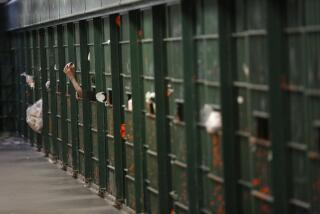Crowded? This jail is anything but
- Share via
The North Facility of Pitchess Detention Center was once home to some 1,600 men. Now it holds just two.
The lucky pair can choose from any of a hundred open beds for a nap. There’s never a line to use the jailhouse pay phones. And come meal time, there’s always enough for seconds.
Amid steep budget cuts, L.A. County jails have been forced to shed inmates in droves, more than any other county jail system in the nation. That drop is most striking at the Castaic facility, where the Sheriff’s Department has cut the inmate count to the bare minimum needed to keep the lockup from falling into disrepair.
Soon, however, facilities like this one might again be bustling, as the state considers moving inmates from its overcrowded prisons to county jails, a plan Sheriff Lee Baca is betting could be a boon for his cash-strapped department.
But in recent months, jail time has felt a lot like summer camp for the fortunate few who have served time at the nearly abandoned lockup.
On a recent morning, a pair of inmates -- one black, the other Latino, members of rival gangs -- lounged on adjacent bunks watching the movie “The Birdcage” on TV. At most jails, picking a channel is highly routinized to avoid fights. Here they can watch most anything they want.
When their wing was full, dozens slept together in one dorm, two to a bunk. With so much vacancy now, the two inmates have claimed keep-away cells typically used for discipline as their own personal bedrooms.
“They call it their suites,” said the sole custody assistant, a middle-aged woman with purple-rimmed eyeglasses and a knit sweater, who watches over the pair.
The inmates spend most of their time however they wish. They play chess and dominoes. They used to play one-on-one on the hoop out back, but those games were short-lived: One is 6 feet, 8 inches tall, the other 5 feet, 7 inches. “I got tired of losing,” said the smaller of the two.
The setup might seem like the plot for a bad sitcom, but sheriff’s officials say it’s a cost-saver. If any facility hit zero inmates -- thus technically closing -- the department would have to get it recertified by the state once the time came to open back up. That would leave the department vulnerable to pricey modifications that could be needed to comply with current building and safety codes.
“Some of them could cost a considerable amount of money,” said Cmdr. Stephen Johnson of the sheriff’s Custody Operations Division. “We don’t want to go there, so that’s why we do it this way.”
Shuttering the jail could also turn minor problems into major headaches. A small leak gone unnoticed for too long, for example, could turn into a collapsed roof. Having a few inmates and sheriff’s staff in the building on a regular basis ensures that lights will be turned on, pests removed and toilets flushed.
The odd arrangement in the Castaic wing is part of a larger effort within the department to save money by shedding inmates and consolidating custody services. According to U.S. Justice Department data, L.A.’s jails lost more than 3,000 inmates in a yearlong span ending in June 2010, almost three times more than the next closest county in the nation. That’s a 15% reduction, well over the national average of about 2%.
According to Sheriff’s Department data, 5,000 jail beds have been made unavailable in the last year and a half, as several lockup compounds have been closed and the North Facility at the Pitchess complex was all but shuttered.
In response to deep funding cuts, male inmates convicted of misdemeanors who were serving roughly 80% of their jail sentences are now typically released after doing just 20% of their time, officials said.
Though some local officials have been skeptical about Gov. Jerry Brown’s plan to send relatively low-level state prisoners to county lockups, Baca has endorsed the idea, as long as it’s sufficiently funded. He says he can house those inmates in his jails at 75% of the cost of keeping them in state prisons. As long as Sacramento transfers the money it would have been spending on its prisoners to the county, Baca says, the plan could leave his department in the black.
“It costs them more to do the same incarceration,” the sheriff said. There’s no available estimate of how much extra funding the county expects to bring in. Baca said he would spend much of that cash on education programs in the jails that would further cut county costs by helping keep inmates from winding up back in local jails.
For the few select inmates who have been keeping the count at the Castaic facility just above zero, the experience has been strange. “Oh yeah, I was big-time confused,” said one of the inmates there last week.
But his stay, he said, has grown to be far more pleasant than his other stints in County Jail.
No need to “keep one eye open” at bedtime, and no gang shot callers barking directives.
“I’m the shot caller now,” joked Linda Danheiser, the custody assistant who watches over the pair.
A reporter was allowed inside the facility on the condition that the inmates were not identified. The inmates who do their time at the facility are there on low-level offenses, such as contempt of court.
With only a couple of inmates, one said, “nobody’s trying to start a riot ... there’s only two of us. We might as well respect each other.
“Jail’s nothing nice,” he said. “But this is better than anything else.”
More to Read
Sign up for Essential California
The most important California stories and recommendations in your inbox every morning.
You may occasionally receive promotional content from the Los Angeles Times.











